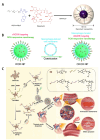Using Molecular Targets to Predict and Treat Aortic Aneurysms
- PMID: 39077712
- PMCID: PMC11262374
- DOI: 10.31083/j.rcm2309307
Using Molecular Targets to Predict and Treat Aortic Aneurysms
Abstract
Aortic aneurysms are life-threatening vascular diseases associated with high morbidity, and usually require prophylactic surgical intervention. Current preventative management of aortic aneurysms relies on the diameter and other anatomic parameters of the aorta, but these have been demonstrated to be insufficient predictive factors of disease progression and potential complications. Studies on pathophysiology of aortic aneurysms could fill this need, which already indicated the significance of specific molecules in aortic aneurysms. These molecules provide more accurate prediction, and they also serve as therapeutic targets, some of which are in preclinical stage. In this review, we summarized the inadequacies and achievements of current clinical prediction standards, discussed the molecular targets in prediction and treatment, and especially emphasized the molecules that have shown potentials in early diagnosis, accurate risk assessment and target treatment of aortic aneurysm at early stage.
Keywords: aortic aneurysm; diagnosis; molecular target; risk stratification; treatment; vascular imaging.
Copyright: © 2022 The Author(s). Published by IMR Press.
Conflict of interest statement
The authors declare no conflict of interest.
Figures



Similar articles
-
Endovascular repair of abdominal aortic aneurysm: an evidence-based analysis.Ont Health Technol Assess Ser. 2002;2(1):1-46. Epub 2002 Mar 1. Ont Health Technol Assess Ser. 2002. PMID: 23074438 Free PMC article.
-
Endovascular stent grafting and open surgical replacement for chronic thoracic aortic aneurysms: a systematic review and prospective cohort study.Health Technol Assess. 2022 Jan;26(6):1-166. doi: 10.3310/ABUT7744. Health Technol Assess. 2022. PMID: 35094747
-
Mycotic aneurysms of the thoracic and abdominal aorta and iliac arteries: experience with anatomic and extra-anatomic repair in 33 cases.J Vasc Surg. 2001 Jan;33(1):106-13. doi: 10.1067/mva.2001.110356. J Vasc Surg. 2001. PMID: 11137930
-
Endovascular repair of descending thoracic aortic aneurysm: an evidence-based analysis.Ont Health Technol Assess Ser. 2005;5(18):1-59. Epub 2005 Nov 1. Ont Health Technol Assess Ser. 2005. PMID: 23074469 Free PMC article.
-
Therapeutic potential of natural products and underlying targets for the treatment of aortic aneurysm.Pharmacol Ther. 2024 Jul;259:108652. doi: 10.1016/j.pharmthera.2024.108652. Epub 2024 Apr 22. Pharmacol Ther. 2024. PMID: 38657777 Review.
References
-
- McClure RS, Brogly SB, Lajkosz K, Payne D, Hall SF, Johnson AP. Epidemiology and management of thoracic aortic dissections and thoracic aortic aneurysms in Ontario, Canada: A population-based study. The Journal of Thoracic and Cardiovascular Surgery . 2018;155:2254–2264.e4. - PubMed
-
- Pape LA, Awais M, Woznicki EM, Suzuki T, Trimarchi S, Evangelista A, et al. Presentation, Diagnosis, and Outcomes of Acute Aortic Dissection: 17-Year Trends From the International Registry of Acute Aortic Dissection. Journal of the American College of Cardiology . 2015;66:350–358. - PubMed
-
- Zommorodi S, Leander K, Roy J, Steuer J, Hultgren R. Understanding abdominal aortic aneurysm epidemiology: socioeconomic position affects outcome. Journal of Epidemiology and Community Health . 2018;72:904–910. - PubMed
-
- Erbel R, Aboyans V, Boileau C, Bossone E, Bartolomeo RD, Eggebrecht H, et al. 2014 ESC Guidelines on the diagnosis and treatment of aortic diseases: Document covering acute and chronic aortic diseases of the thoracic and abdominal aorta of the adult. The Task Force for the Diagnosis and Treatment of Aortic Diseases of the European Society of Cardiology (ESC) European Heart Journal . 2014;35:2873–2926. - PubMed
Publication types
LinkOut - more resources
Full Text Sources

